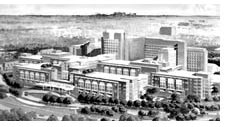 |
||||
|
2001 saw the accomplishment of several construction milestones. By year’s end construction was 55 percent complete with the concrete structure in place; a substantial part of the main mechanical and electrical systems installed; and the building exterior wall system 30 percent complete. Construction of interior spaces began in mid-2001. The CRC will have 234 inpatient beds, 68 day-hospital stations and research laboratories. The new center will connect to the existing Warren Grant Magnuson Clinical Center, a 267-bed facility with a 14-story ambulatory care wing. A hallmark of this original building is the proximity of patient care units to scientific labs. The CRC will maintain the tradition of rapidly moving biomedical findings from the laboraroty into the mainstream of medical practice. Outpatient clinics currently housed in the Ambulatory Care Research facility will remain in the existing building, keeping them adjacent to inpatient units. Revitalization and transition plans are being formulated in preparation and readiness for completion of the CRC. Design of the CRC reflects the dual priorities of patient care and clinical research, accommodating the physical requirements of the latest in medical technology while providing a friendly atmosphere and efficient environment for patients and clinical investigators. Four brick wings, paired around landscaped courtyards, will flank a glass-enclosed science court atrium that will serve as the core of the new complex. The new three- and four-story wings sweeping across the front of the existing building will allow patients and scientists to take advantage of the views of NIH’s campus setting. The primary design features encompass:
Ground was broken for the CRC by former Vice President Al Gore, former Senator Mark O. Hatfield and others in late 1997. The CRC is named in honor of Senator Hatfield of Oregon, who supported medical research throughout his career in Congress, served in the Senate for 30 years and chaired the appropriations committee for eight years. |
Clinical Center Governance and Accreditation The Mark O. Hatfield Clinical Research Center The Edmond J. Safra Family Lodge Clinical Research Training Programs |
|||
 The Mark O. Hatfield Clinical Research Center (CRC) has begun to take shape. The CRC, expected to be complete in 2004, will be home to new inpatient units, day hospitals and research labs. Together, the existing Warren Grant Magnuson and new Hatfield centers will provide the environment today’s clinical researchers need for advancing clinical science.
The Mark O. Hatfield Clinical Research Center (CRC) has begun to take shape. The CRC, expected to be complete in 2004, will be home to new inpatient units, day hospitals and research labs. Together, the existing Warren Grant Magnuson and new Hatfield centers will provide the environment today’s clinical researchers need for advancing clinical science.